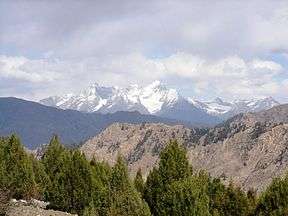Astore Valley
| Astore Valley | |
|---|---|
|
An unnamed, 5400-metre peak raises jagged, snowclad ramparts above Astore Valley | |
 Astore Valley | |
| Floor elevation | 2,600 m (8,500 ft) |
| Long-axis length | 120 km (75 mi) |
| Geography | |
| Coordinates | 35°02′20.3″N 75°06′36.9″E / 35.038972°N 75.110250°ECoordinates: 35°02′20.3″N 75°06′36.9″E / 35.038972°N 75.110250°E |
Astore Valley (el. 2,600 m (8,500 ft)) is located in Astore District in the Pakistani region of Gilgit-Baltistan. The valley, adjoining the eastern side of mountain Nanga Parbat, is about 120 km (75 mi) long, having area of 5,092 km2 (1,966 sq mi).
The entrance of the valley is located about 60 km southeast of Gilgit with four side-valleys. The valley has more than 100 villages with a total population of 71,666 (Census 1998), including Gudai, Shekong, Dass Kariam, Loas, Louze, Chilm, Bubin, Gorikot, Parisheng Eid Ghah, Fina, Bulen, Chongra, Tari Shing, Rattu, Kamri, and Minimerg. Rama lake and pastures are the most famous tourist attraction in the region. The majority of people practice subsistence agriculture and livestock is the main source of livelihood complemented by seasonal work in down districts of the country. Due to its diverse landscape and climatic conditions the valley provides excellent habitat for a variety of commercially important medicinal plants.
History
According to the Imperial Gazetteer of India, around 1600:
Ghāzī Mukhpun, a Persian adventurer, is said to have married a princess of the Skārdu reigning family. The four sons born of this union became Rās of Skārdu, Astor, Rondu, and Kharmang respectively, and from them are descended the families of the present chiefs of those places. The independence of Astor ceased at the Dogra conquest.[1]
Climate
Astore valley has a moderate climate during summer. In winter it can snow up to 6 in (150 mm) in the main valleys and up to 2 to 3 ft (0.61 to 0.91 m) in the mountains. In Mirmalik valley it snows up to 6 ft (1.8 m) in February.
Languages
The main language spoken in the valley is Shina. Urdu, which is the national language of Pakistan, is the second most frequently spoken language. Shina has many sub-dialects especially significant in Bunji, Dashkin, Doyan, Praishing, Gorikot, across the Burzil and Rattu regions. Shina is mild phonetically and uses the Arabic script. Poetry is not recorded, rather it is transmitted via folk songs and part of stories narrated by folk singers and artisans. Astore, a corridor to Dardistan, has a rich linguistic background due to its centuries old connections with the rest of the Indian subcontinent. People living in this region were frequent visitors to India for trade and education and had access to the maharajas' royal courts. British officers visiting and surveying led to an admixture of foreign words in the local language.
See also
References
- ↑ Gilgit - Imperial Gazetteer of India, v. 12, p. 239 According to the Imperial Gazetteer, which was compiled in the first decade of the twentieth century, the marriage took place over three hundred years ago
